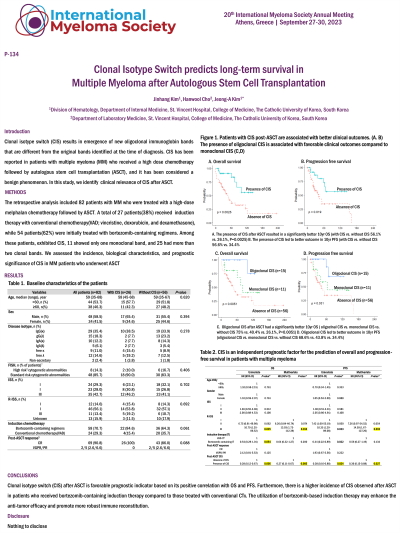Treatment of Newly Diagnosed Myeloma - Transplant Eligible
Poster Session 1
P-134: Clonal Isotype Switch predicts long-term survival in Multiple Myeloma after Autologous Stem Cell Transplantation.
Wednesday, September 27, 2023
1:30 PM - 2:30 PM EEST


Jin Hang Kim, MD (she/her/hers)
Clinical instructor
St. Vincent Hospital, College of Medicine, The Catholic University of Korea
Introduction: Clonal isotype switch (CIS) results in emergence of new oligoclonal immunoglobin bands that are different from the original bands identified at the time of diagnosis. CIS has been reported in patients with multiple myeloma (MM) who received a high dose melphalan chemotherapy followed by autologous stem cell transplantation (ASCT). However, clinical relevance of CIS after ASCT is still unclear.
Methods: The retrospective analysis included 82 patients with MM who had undergone ASCT. 27 patients (38%) received a vincristine, doxorubicin and dexamethasone (VAD) as an induction treatment (IT), while 54 patients (62%) were initially treated with the bortezomib-containing IT. A CIS was observed in 26 patients (31%) of the 82 patients with a higher prevalence with the use of novel agents versus VAD in induction (40% vs. 15%; P=0.061).
Results: In prognostic terms, revised international scoring system (R-ISS) and post-ASCT CIS status remained at a significant predictor in OS and PFS in the multivariate analysis. Interestingly, patients with CIS after ASCT had a significantly longer 10-year overall survival (OS; with CIS vs. without CIS; 56% vs. 25%, respectively; p=0.002) and 10-year progression-free survival (PFS; with CIS vs. without CIS; 52% vs. 32%, respectively; p=0.02). Among 26 patients with CIS, 11 patients had only one monoclonal band and 15 patients had developed oligoclonal bands (>2 monoclonal bands) throughout the post-ASCT follow-up period. Oligoclonal CIS was observed about 18% of patients in total 82 patients. Interestingly, the estimated 10-year OS and PFS of CIS patients with oligoclonal bands were 75.0% and 68.6%, respectively.
Conclusions: CIS after ASCT is a favorable prognostic indicator based on its positive correlation with OS and PFS after transplantation in patients with MM. In addition, a higher frequency of CIS after ASCT was associated with the bortezomib-containing IT. The use of bortezomib-containing IT may contribute to a higher anti-tumor effect or a stronger immune reconstitution.
Methods: The retrospective analysis included 82 patients with MM who had undergone ASCT. 27 patients (38%) received a vincristine, doxorubicin and dexamethasone (VAD) as an induction treatment (IT), while 54 patients (62%) were initially treated with the bortezomib-containing IT. A CIS was observed in 26 patients (31%) of the 82 patients with a higher prevalence with the use of novel agents versus VAD in induction (40% vs. 15%; P=0.061).
Results: In prognostic terms, revised international scoring system (R-ISS) and post-ASCT CIS status remained at a significant predictor in OS and PFS in the multivariate analysis. Interestingly, patients with CIS after ASCT had a significantly longer 10-year overall survival (OS; with CIS vs. without CIS; 56% vs. 25%, respectively; p=0.002) and 10-year progression-free survival (PFS; with CIS vs. without CIS; 52% vs. 32%, respectively; p=0.02). Among 26 patients with CIS, 11 patients had only one monoclonal band and 15 patients had developed oligoclonal bands (>2 monoclonal bands) throughout the post-ASCT follow-up period. Oligoclonal CIS was observed about 18% of patients in total 82 patients. Interestingly, the estimated 10-year OS and PFS of CIS patients with oligoclonal bands were 75.0% and 68.6%, respectively.
Conclusions: CIS after ASCT is a favorable prognostic indicator based on its positive correlation with OS and PFS after transplantation in patients with MM. In addition, a higher frequency of CIS after ASCT was associated with the bortezomib-containing IT. The use of bortezomib-containing IT may contribute to a higher anti-tumor effect or a stronger immune reconstitution.
